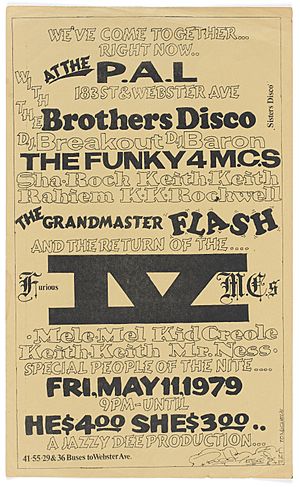Buddy Esquire facts for kids
Buddy Esquire (born July 17, 1958 – died January 31, 2014) was a very famous artist who designed flyers for hip-hop shows. He worked in the Bronx, New York, during the early days of hip-hop, from 1978 to 1982. Buddy taught himself how to draw and design by reading books from his local library. He was inspired by graffiti, Japanese anime, superhero comics, and a type of art called Art Deco.
Buddy Esquire created flyers for many hip-hop legends. These included Grandmaster Flash, Afrika Bambaataa, Kool Herc, the Funky 4 Plus 1, and the Cold Crush Brothers. His unique visual style helped shape the look of early hip-hop. His flyers are important because they are some of the only original materials showing how this popular music style first developed. Many of his designs looked like old jukeboxes or theater signs. His art used strong dark and light shapes, and he playfully mixed letters, pictures, and decorations.
Early Life and Art
Buddy Esquire was born in the Bronx, New York. He lived in a place called the James Monroe Houses. In 1972, he started creating graffiti. He used the names "ESQ" and "Phantom 1" for his tags. Making graffiti helped him practice his art skills. He once said, "I kept practicing and eventually I got better at handling letter form." He stopped doing graffiti in the early 1980s.
Designing for Hip-Hop
Buddy was an artist who taught himself everything. In 1977, he started painting names on clothes, like jeans. In the same year, he began making flyers. His very first flyer was for a neighborhood block party. He learned how to design posters by reading books from the public library.
He called his special style "Neo-deco." Buddy Esquire used borders and fonts that looked like Art Deco designs. He often used special dry-transfer letters from a company called Letraset. Even though graffiti was linked to hip-hop back then, Buddy wanted his show flyers to look professional and stylish. He wanted them to be easy to read and have a classy feel. This was different from where most early hip-hop shows happened, which were often in high schools or community centers in the Bronx.
Buddy said, "That's what I tried for, you know: give it a level of class even though it was just a ghetto jam." He often used a font family called Broadway, which was inspired by Art Deco. In 1978 and 1979, he could draw letters perfectly by hand. But by 1980, he chose to use the transferable lettering instead.
Legacy and Impact
Buddy Esquire passed away in 2014 at the age of 55 due to a kitchen accident. He died from breathing in smoke. Even though he made huge contributions to design, he didn't earn a lot of money from his art. He worked for UPS for most of his life.
Many famous people from early hip-hop attended his funeral. These included Afrika Bambaataa, Charlie Ahearn, and Theodore Livingston. Buddy Esquire's amazing artwork is now kept safe at Cornell University. In 2015, a book of his handbills was published. It was called "Buddy Esquire: King of the Hip Hop Flyer."


